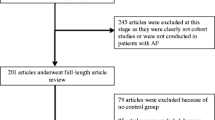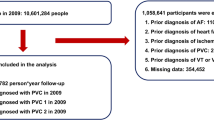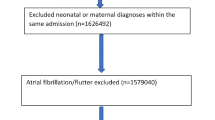Abstract
Purpose of Review
Excessive supraventricular ectopic activity (ESVEA), in the form of frequent premature atrial contractions (PACs) and runs of PACs, is commonly observed in clinical practice and is frequently considered to be benign. Yet, recent studies have demonstrated a link between ESVEA and adverse cardiovascular outcomes. The aim of this meta-analysis was to examine the association between ESVEA and the risk of atrial fibrillation (AF), stroke, and mortality.
Recent Findings
A systematic search was performed in PubMed, EMBASE, and the Cochrane Library up to December 2017 to identify studies assessing adverse cardiovascular outcomes in patients with ESVEA, recorded on ambulatory electrocardiography. ESVEA was defined as a burden of PACs > 30 PACs/h or any runs of ≥20 PACs. The risk estimates for EVSEA and each clinical endpoint were pooled and analyzed separately.
Results
Five studies comprising 7545 participants were included in this meta-analysis. The pooled analysis showed that ESVEA doubled the risk of AF (HR 2.19, 95% CI 1.70–2.82). ESVEA was also associated with a higher incidence of stroke (HR 2.23, 95% CI 1.24–4.02). Finally, ESVEA was associated with higher all-cause mortality (HR 1.61, 95% CI 1.25–2.07).
Summary
Our meta-analysis found that ESVEA is closely associated with AF, stroke, and all-cause mortality. Further studies are required to examine the implication of therapeutic strategies in patients with ESVEA, in order to prevent potential subsequent adverse cardiovascular outcomes.



Similar content being viewed by others
References
Papers of particular interest, published recently, have been highlighted as: • Of importance •• Of major importance
Folarin VA, Fitzsimmons PJ, Kruyer WB. Holter monitor findings in asymptomatic male military aviators without structural heart disease. Aviat Space Environ Med. 2001;72(9):836–8.
Conen D, Adam M, Roche F, Barthelemy JC, Felber Dietrich D, Imboden M, et al. Premature atrial contractions in the general population: frequency and risk factors. Circulation. 2012;126(19):2302–8. https://doi.org/10.1161/CIRCULATIONAHA.112.112300.
Fleg JL, Kennedy HL. Long-term prognostic significance of ambulatory electrocardiographic findings in apparently healthy subjects greater than or equal to 60 years of age. Am J Cardiol. 1992;70(7):748–51.
Glasser SP, Clark PI, Applebaum HJ. Occurrence of frequent complex arrhythmias detected by ambulatory monitoring: findings in an apparently healthy asymptomatic elderly population. Chest. 1979;75(5):565–8.
Kantelip JP, Sage E, Duchene-Marullaz P. Findings on ambulatory electrocardiographic monitoring in subjects older than 80 years. Am J Cardiol. 1986;57(6):398–401.
Camm AJ, Evans KE, Ward DE, Martin A. The rhythm of the heart in active elderly subjects. Am Heart J. 1980;99(5):598–603.
Taylor IC, Stout RW. The significance of cardiac arrhythmias in the aged. Age Ageing. 1983;12(1):21–8.
Fleg JL, Kennedy HL. Cardiac arrhythmias in a healthy elderly population: detection by 24-hour ambulatory electrocardiography. Chest. 1982;81(3):302–7.
Bennett MA, Pentecost BL. The pattern of onset and spontaneous cessation of atrial fibrillation in man. Circulation. 1970;41(6):981–8.
Haissaguerre M, Jais P, Shah DC, Takahashi A, Hocini M, Quiniou G, et al. Spontaneous initiation of atrial fibrillation by ectopic beats originating in the pulmonary veins. N Engl J Med. 1998;339(10):659–66. https://doi.org/10.1056/nejm199809033391003.
Kolb C, Nurnberger S, Ndrepepa G, Zrenner B, Schomig A, Schmitt C. Modes of initiation of paroxysmal atrial fibrillation from analysis of spontaneously occurring episodes using a 12-lead Holter monitoring system. Am J Cardiol. 2001;88(8):853–7.
Gong Y, Xie F, Stein KM, Garfinkel A, Culianu CA, Lerman BB, et al. Mechanism underlying initiation of paroxysmal atrial flutter/atrial fibrillation by ectopic foci: a simulation study. Circulation. 2007;115(16):2094–102. https://doi.org/10.1161/circulationaha.106.656504.
Jensen TJ, Haarbo J, Pehrson SM, Thomsen B. Impact of premature atrial contractions in atrial fibrillation. Pacing Clin Electrophysiol. 2004;27(4):447–52. https://doi.org/10.1111/j.1540-8159.2004.00462.x.
Chen SA, Hsieh MH, Tai CT, Tsai CF, Prakash VS, Yu WC, et al. Initiation of atrial fibrillation by ectopic beats originating from the pulmonary veins: electrophysiological characteristics, pharmacological responses, and effects of radiofrequency ablation. Circulation. 1999;100(18):1879–86.
Waktare JE, Hnatkova K, Sopher SM, Murgatroyd FD, Guo X, Camm AJ, et al. The role of atrial ectopics in initiating paroxysmal atrial fibrillation. Eur Heart J. 2001;22(4):333–9. https://doi.org/10.1053/euhj.2000.2517.
Cheriyath P, He F, Peters I, Li X, Alagona P Jr, Wu C, et al. Relation of atrial and/or ventricular premature complexes on a two-minute rhythm strip to the risk of sudden cardiac death (the Atherosclerosis Risk in Communities [ARIC] study). Am J Cardiol. 2011;107(2):151–5. https://doi.org/10.1016/j.amjcard.2010.09.002.
Ofoma U, He F, Shaffer ML, Naccarelli GV, Liao D. Premature cardiac contractions and risk of incident ischemic stroke. J Am Heart Assoc. 2012;1(5):e002519. https://doi.org/10.1161/JAHA.112.002519.
Inohara T, Kohsaka S, Okamura T, Watanabe M, Nakamura Y, Higashiyama A, et al. Long-term outcome of healthy participants with atrial premature complex: a 15-year follow-up of the NIPPON DATA 90 cohort. PLoS One. 2013;8(11):e80853. https://doi.org/10.1371/journal.pone.0080853.
Qureshi W, Shah AJ, Salahuddin T, Soliman EZ. Long-term mortality risk in individuals with atrial or ventricular premature complexes (results from the Third National Health and Nutrition Examination Survey). Am J Cardiol. 2014;114(1):59–64. https://doi.org/10.1016/j.amjcard.2014.04.005.
Murakoshi N, Xu D, Sairenchi T, Igarashi M, Irie F, Tomizawa T, et al. Prognostic impact of supraventricular premature complexes in community-based health checkups: the Ibaraki Prefectural Health Study. Eur Heart J. 2015;36(3):170–8. https://doi.org/10.1093/eurheartj/ehu407.
Perez MV, Dewey FE, Marcus R, Ashley EA, Al-Ahmad AA, Wang PJ, et al. Electrocardiographic predictors of atrial fibrillation. Am Heart J. 2009;158(4):622–8. https://doi.org/10.1016/j.ahj.2009.08.002.
Nguyen KT, Vittinghoff E, Dewland TA, Dukes JW, Soliman EZ, Stein PK, et al. Ectopy on a single 12-lead ECG, incident cardiac myopathy, and death in the community. J Am Heart Assoc. 2017;6(8). https://doi.org/10.1161/JAHA.117.006028.
Engstrom G, Hedblad B, Juul-Moller S, Tyden P, Janzon L. Cardiac arrhythmias and stroke: increased risk in men with high frequency of atrial ectopic beats. Stroke. 2000;31(12):2925–9.
Binici Z, Intzilakis T, Nielsen OW, Kober L, Sajadieh A. Excessive supraventricular ectopic activity and increased risk of atrial fibrillation and stroke. Circulation. 2010;121(17):1904–11. https://doi.org/10.1161/CIRCULATIONAHA.109.874982.
Larsen BS, Kumarathurai P, Falkenberg J, Nielsen OW, Sajadieh A. Excessive atrial ectopy and short atrial runs increase the risk of stroke beyond incident atrial fibrillation. J Am Coll Cardiol. 2015;66(3):232–41. https://doi.org/10.1016/j.jacc.2015.05.018.
Chong BH, Pong V, Lam KF, Liu S, Zuo ML, Lau YF, et al. Frequent premature atrial complexes predict new occurrence of atrial fibrillation and adverse cardiovascular events. Europace. 2012;14(7):942–7. https://doi.org/10.1093/europace/eur389.
Lin CY, Lin YJ, Chen YY, Chang SL, Lo LW, Chao TF, et al. Prognostic significance of premature atrial complexes burden in prediction of long-term outcome. J Am Heart Assoc. 2015;4(9):e002192. https://doi.org/10.1161/JAHA.115.002192.
Dewland TA, Vittinghoff E, Mandyam MC, Heckbert SR, Siscovick DS, Stein PK, et al. Atrial ectopy as a predictor of incident atrial fibrillation: a cohort study. Ann Intern Med. 2013;159(11):721–8. https://doi.org/10.7326/0003-4819-159-11-201312030-00004.
Nguyen KT, Vittinghoff E, Dewland TA, Mandyam MC, Stein PK, Soliman EZ, et al. Electrocardiographic predictors of incident atrial fibrillation. Am J Cardiol. 2016;118(5):714–9. https://doi.org/10.1016/j.amjcard.2016.06.008.
Acharya T, Tringali S, Bhullar M, Nalbandyan M, Ilineni VK, Carbajal E, et al. Frequent atrial premature complexes and their association with risk of atrial fibrillation. Am J Cardiol. 2015;116(12):1852–7. https://doi.org/10.1016/j.amjcard.2015.09.025.
Kumarathurai P, Mouridsen MR, Mattsson N, Larsen BS, Nielsen OW, Gerds TA, et al. Atrial ectopy and N-terminal pro-B-type natriuretic peptide as predictors of atrial fibrillation: a population-based cohort study. Europace. 2017;19(3):364–70. https://doi.org/10.1093/europace/euw017.
Suzuki S, Sagara K, Otsuka T, Kano H, Matsuno S, Takai H, et al. Usefulness of frequent supraventricular extrasystoles and a high CHADS2 score to predict first-time appearance of atrial fibrillation. Am J Cardiol. 2013;111(11):1602–7. https://doi.org/10.1016/j.amjcard.2013.01.335.
Johnson LS, Juhlin T, Juul-Moller S, Hedblad B, Nilsson PM, Engstrom G. A prospective study of supraventricular activity and incidence of atrial fibrillation. Heart Rhythm. 2015;12(9):1898–904. https://doi.org/10.1016/j.hrthm.2015.04.042.
Miller DJ, Khan MA, Schultz LR, Simpson JR, Katramados AM, Russman AN, et al. Outpatient cardiac telemetry detects a high rate of atrial fibrillation in cryptogenic stroke. J Neurol Sci. 2013;324(1–2):57–61. https://doi.org/10.1016/j.jns.2012.10.001.
Wallmann D, Tuller D, Wustmann K, Meier P, Isenegger J, Arnold M, et al. Frequent atrial premature beats predict paroxysmal atrial fibrillation in stroke patients: an opportunity for a new diagnostic strategy. Stroke. 2007;38(8):2292–4.
Yodogawa K, Seino Y, Ohara T, Hayashi M, Miyauchi Y, Katoh T, et al. Prediction of atrial fibrillation after ischemic stroke using P-wave signal averaged electrocardiography. J Cardiol. 2013;61(1):49–52. https://doi.org/10.1016/j.jjcc.2012.08.013.
Pinho J, Braga CG, Rocha S, Santos AF, Gomes A, Cabreiro A, et al. Atrial ectopic activity in cryptogenic ischemic stroke and TIA: a risk factor for recurrence. J Stroke Cerebrovasc Dis. 2015;24(2):507–10. https://doi.org/10.1016/j.jstrokecerebrovasdis.2014.09.029.
Sudacevschi V, Bertrand C, Chadenat ML, Tarnaud C, Pico F. Predictors of occult atrial fibrillation in one hundred seventy-one patients with cryptogenic transient ischemic attack and minor stroke. J Stroke Cerebrovasc Dis. 2016;25(11):2673–7. https://doi.org/10.1016/j.jstrokecerebrovasdis.2016.07.014.
•• Vinther KH, Tveskov C, Moller S, Auscher S, Osmanagic A, Egstrup K. Excessive premature atrial complexes and the risk of recurrent stroke or death in an ischemic stroke population. J Stroke Cerebrovasc Dis. 2017;26(6):1163–70. https://doi.org/10.1016/j.jstrokecerebrovasdis.2016.10.038A prospective cohort study investigated the potential association of premature atrial complexes (> 14 PAC per hour and three or more runs of premature atrial complexes per 24 h) between recurrent stroke or death in patients with ischemic stroke. These results confirmed excessive premature atrial complexes were associated with a higher risk of recurrent stroke or death.
Kochhauser S, Dechering DG, Dittrich R, Reinke F, Ritter MA, Ramtin S, et al. Supraventricular premature beats and short atrial runs predict atrial fibrillation in continuously monitored patients with cryptogenic stroke. Stroke. 2014;45(3):884–6. https://doi.org/10.1161/STROKEAHA.113.003788.
Chong JJ, Kumar S, Thomas L, Thomas S. Supraventricular ectopy and recurrence of atrial fibrillation after electrical cardioversion. Europace. 2006;8(5):341–4. https://doi.org/10.1093/europace/eul008.
Varounis C, Dagres N, Maounis T, Panagiotakos D, Cokkinos DV. Atrial premature complexes and heart rate have prognostic significance in 1-month atrial fibrillation recurrence after electrical cardioversion. Europace. 2007;9(8):633–7. https://doi.org/10.1093/europace/eum090.
Kim IS, Yang PS, Kim TH, Park J, Park JK, Uhm JS, et al. Clinical significance of additional ablation of atrial premature beats after catheter ablation for atrial fibrillation. Yonsei Med J. 2016;57(1):72–80. https://doi.org/10.3349/ymj.2016.57.1.72.
Gang UJ, Nalliah CJ, Lim TW, Thiagalingam A, Kovoor P, Ross DL, et al. Atrial ectopy predicts late recurrence of atrial fibrillation after pulmonary vein isolation. Circ Arrhythm Electrophysiol. 2015;8(3):569–74. https://doi.org/10.1161/CIRCEP.114.002052.
Chun KJ, Hwang JK, Choi SR, Park SJ, On YK, Kim JS, et al. Electrocardiogram PR interval is a surrogate marker to predict new occurrence of atrial fibrillation in patients with frequent premature atrial contractions. J Korean Med Sci. 2016;31(4):519–24. https://doi.org/10.3346/jkms.2016.31.4.519.
Chun KJ, Hwang JK, Park SJ, On YK, Kim JS, Park KM. Electrical PR interval variation predicts new occurrence of atrial fibrillation in patients with frequent premature atrial contractions. Medicine (Baltimore). 2016;95(14):e3249. https://doi.org/10.1097/MD.0000000000003249.
Mattsson N, Kumarathurai P, Larsen BS, Nielsen OW, Sajadieh A. Mild hypokalemia and supraventricular ectopy increases the risk of stroke in community-dwelling subjects. Stroke. 2017;48(3):537–43. https://doi.org/10.1161/STROKEAHA.116.015439.
• Marinheiro R, Parreira L, Amador P, Sa C, Duarte T, Caria R. Excessive atrial ectopic activity as an independent risk factor for ischemic stroke. Int J Cardiol. 2017;249:226–30. https://doi.org/10.1016/j.ijcard.2017.08.054This study included in this meta-analysis demonstrated that in the patients without stroke or AF, having > 30 PACs/h was independently associated with a higher risk of AF and death but only subjects with > 97 PACs/h had a higher risk of ischemic stroke.
Madigan E, Schmotzer BJ, Struk CJ, DiCarlo CM, Kikano G, Pina IL, et al. Home health care with telemonitoring improves health status for older adults with heart failure. Home Health Care Serv Q. 2013;32(1):57–74. https://doi.org/10.1080/01621424.2012.755144.
Killip T, Gault JH. Mode of onset of atrial fibrillation in man. Am Heart J. 1965;70:172–9.
Vincenti A, Brambilla R, Fumagalli MG, Merola R, Pedretti S. Onset mechanism of paroxysmal atrial fibrillation detected by ambulatory Holter monitoring. Europace. 2006;8(3):204–10. https://doi.org/10.1093/europace/euj043.
Hohnloser SH, Healey JS, Gold MR, Israel CW, Yang S, van Gelder I, et al. Atrial overdrive pacing to prevent atrial fibrillation: insights from ASSERT. Heart Rhythm. 2012;9(10):1667–73. https://doi.org/10.1016/j.hrthm.2012.06.012.
Hirsh BJ, Copeland-Halperin RS, Halperin JL. Fibrotic atrial cardiomyopathy, atrial fibrillation, and thromboembolism: mechanistic links and clinical inferences. J Am Coll Cardiol. 2015;65(20):2239–51. https://doi.org/10.1016/j.jacc.2015.03.557.
Watson T, Shantsila E, Lip GY. Mechanisms of thrombogenesis in atrial fibrillation: Virchow’s triad revisited. Lancet. 2009;373(9658):155–66. https://doi.org/10.1016/s0140-6736(09)60040-4.
Kirchhof P, Benussi S, Kotecha D, Ahlsson A, Atar D, Casadei B, et al. 2016 ESC guidelines for the management of atrial fibrillation developed in collaboration with EACTS. Eur J Cardiothorac Surg. 2016;50(5):e1–e88. https://doi.org/10.1093/ejcts/ezw313.
Soliman EZ, Safford MM, Muntner P, Khodneva Y, Dawood FZ, Zakai NA, et al. Atrial fibrillation and the risk of myocardial infarction. JAMA Intern Med. 2014;74(1):107–14. https://doi.org/10.1001/jamainternmed.2013.11912.
Nagueh SF, Smiseth OA, Appleton CP, Byrd BF 3rd, Dokainish H, Edvardsen T, et al. Recommendations for the evaluation of left ventricular diastolic function by echocardiography: an update from the American Society of Echocardiography and the European Association of Cardiovascular Imaging. Eur Heart J Cardiovasc Imaging. 2016;17(12):1321–60. https://doi.org/10.1093/ehjci/jew082.
•• Himmelreich JCL, Lucassen WAM, Heugen M, Bossuyt PMM, Tan HL, Harskamp RE, et al. Frequent premature atrial contractions are associated with atrial fibrillation, brain ischaemia, and mortality: a systematic review and meta-analysis. Europace. 2019;21(5):698-707. https://doi.org/10.1093/europace/euy276This was one of the most recent meta-analysis comparing the association between PACs on ECG as well as PAC-count on Holter and AF, brain ischemia and all-cause mortality in patients without a history of AF, showing that frequent PACs on 24–48 h Holter were significantly associated with AF, stroke, and mortality.
Funding
This work was supported by the National Natural Science Foundation of China (81970270, 81570298, 30900618, and 81270245 to T.L.), the Tianjin Natural Science Foundation (16JCZDJC34900 to T.L.), and the Croucher Foundation of Hong Kong (Clinical Assistant Professorship to GT).
Author information
Authors and Affiliations
Corresponding authors
Ethics declarations
Conflict of Interest
Lei Meng, Georgios Tsiaousis, Jinli He, Gary Tse, Konstantinos P. Letsas, Adrian Baranchuk, Wenwei Qi, Zhiwei Zhang, Enzhao Liu, Gang Xu, Yunlong Xia, Guangping Li, Leonardo Roever, Nikolaos Fragakis, and Tong Liu each declare that they have no conflict of interest. Antonios P. Antoniadis reports personal fees from PromoPharma SA, outside the submitted work Panagiotis Korantzopoulos reports personal fees from MEDTRONIC, personal fees from PFIZER, personal fees from BAYER, and personal fees from BOEHRINGER-INGELHEIM, outside the submitted work. Gregory YH Lip has served as a consultant for Bayer/Janssen, Bristol-Myers Squibb/Pfzer, Biotronik, Medtronic, Boehringer Ingelheim, Novartis, Verseon, and Daiichi Sankyo, and as a speaker for Bayer, Bristol-Myers Squibb/Pfzer, Medtronic, Boehringer Ingelheim, and Daiichi Sankyo.
Human and Animal Rights and Informed Consent
This article does not contain any studies with human or animal subjects performed by any of the authors.
Additional information
Publisher’s Note
Springer Nature remains neutral with regard to jurisdictional claims in published maps and institutional affiliations.
This article is part of the Topical Collection on Evidence-Based Medicine, Clinical Trials and Their Interpretations
Electronic Supplementary Material
ESM 1
(DOCX 777 kb)
Rights and permissions
About this article
Cite this article
Meng, L., Tsiaousis, G., He, J. et al. Excessive Supraventricular Ectopic Activity and Adverse Cardiovascular Outcomes: a Systematic Review and Meta-analysis. Curr Atheroscler Rep 22, 14 (2020). https://doi.org/10.1007/s11883-020-0832-4
Published:
DOI: https://doi.org/10.1007/s11883-020-0832-4




